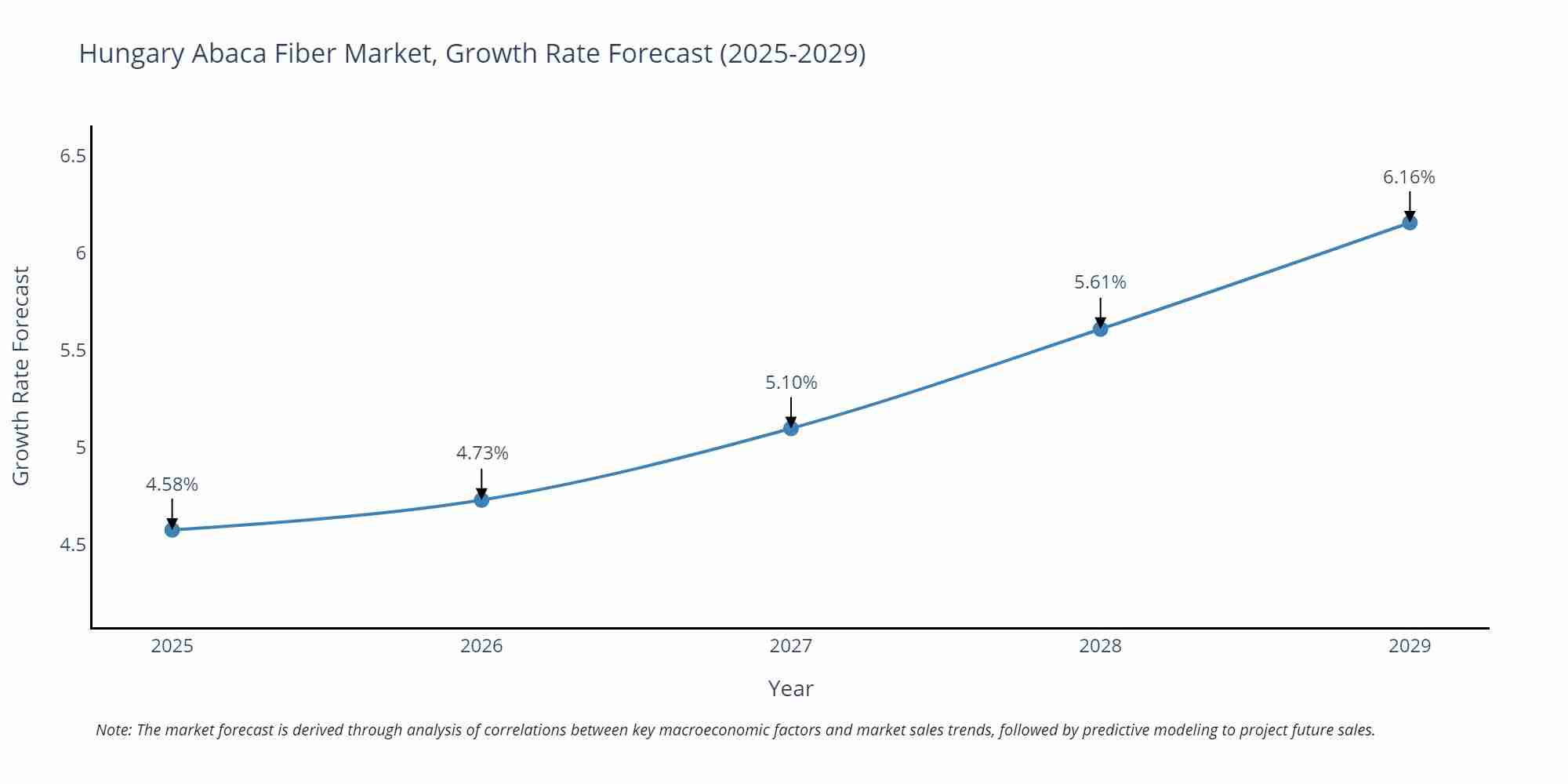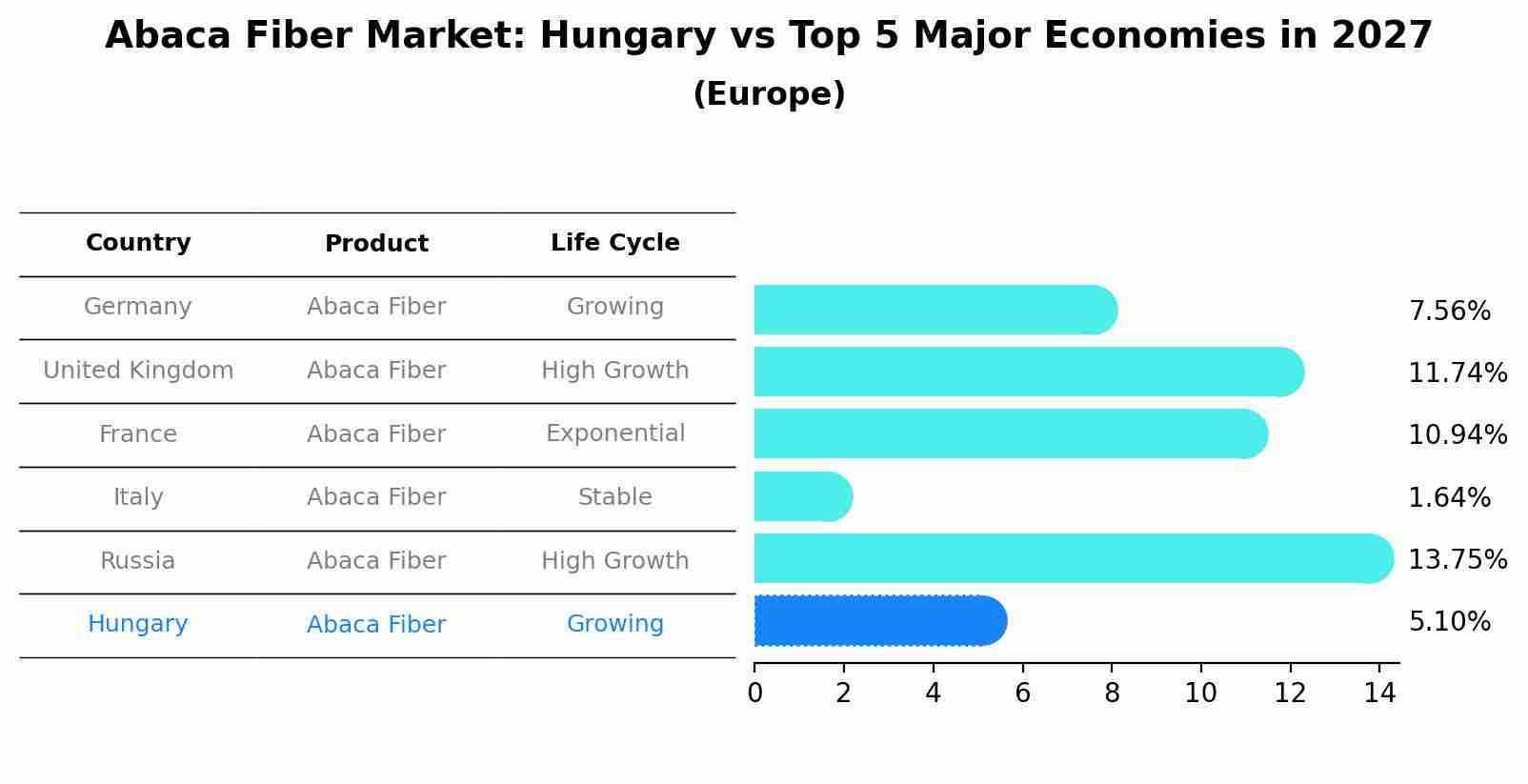Hungary Abaca Fiber Market Outlook | Analysis, Trends, COVID-19 IMPACT, Industry, Size, Revenue, Value, Forecast, Share, Growth & Companies
| Product Code: ETC236779 | Publication Date: Aug 2022 | Updated Date: Jul 2025 | Product Type: Market Research Report | |
| Publisher: 6Wresearch | Author: Shubham Padhi | No. of Pages: 75 | No. of Figures: 35 | No. of Tables: 20 |
Hungary Abaca Fiber Market Size Growth Rate
The Hungary Abaca Fiber Market is poised for steady growth rate improvements from 2025 to 2029. From 4.58% in 2025, the growth rate steadily ascends to 6.16% in 2029.

Abaca Fiber Market: Hungary vs Top 5 Major Economies in 2027 (Europe)
The Abaca Fiber market in Hungary is projected to grow at a growing growth rate of 5.10% by 2027, within the Europe region led by Germany, along with other countries like United Kingdom, France, Italy and Russia, collectively shaping a dynamic and evolving market environment driven by innovation and increasing adoption of emerging technologies.

Hungary Abaca Fiber Market Overview
The Hungary Abaca Fiber Market is witnessing steady growth due to the increasing demand for eco-friendly and sustainable materials in various industries. Abaca fibers, also known as Manila hemp, are derived from the Musa textilis plant and are valued for their strength, durability, and versatility. In Hungary, the market for abaca fibers is driven by the automotive, textile, and paper industries, where these fibers are used in manufacturing products such as car interiors, textiles, and specialty papers. The growing awareness about the environmental benefits of abaca fibers, such as their biodegradability and renewable nature, is further fueling market growth. Key players in the Hungary Abaca Fiber Market include manufacturers, exporters, and distributors who are focusing on expanding their product portfolios and strengthening their distribution networks to meet the increasing demand for sustainable materials in the country.
Hungary Abaca Fiber Market Trends
In Hungary, the Abaca Fiber Market is experiencing steady growth driven by the increasing demand for eco-friendly and sustainable materials in various industries. Abaca fiber, also known as Manila hemp, is gaining popularity due to its strength, durability, and biodegradability, making it a preferred choice for applications such as textiles, paper products, and handicrafts. The market is witnessing a shift towards incorporating abaca fiber in the production of eco-friendly packaging materials, home furnishings, and automotive components. Manufacturers are also focusing on developing innovative processes to enhance the quality and versatility of abaca fiber, further fueling its demand in the market. With the growing awareness of environmental conservation and sustainable practices, the Hungary Abaca Fiber Market is projected to continue its upward trajectory in the coming years.
Hungary Abaca Fiber Market Challenges
In the Hungary Abaca Fiber Market, some of the key challenges faced include limited production capacity due to the labor-intensive nature of abaca cultivation and processing, fluctuating demand from industries such as textile and paper due to changing consumer preferences and economic conditions, competition from alternative natural and synthetic fibers, and lack of awareness about the benefits and potential applications of abaca fiber among potential customers. Additionally, securing consistent and reliable supply chains for raw materials can be a challenge, as abaca is primarily grown in tropical regions and is subject to weather-related risks. Overcoming these challenges would require investment in technology and infrastructure to increase efficiency and productivity, as well as targeted marketing efforts to promote the unique qualities of abaca fiber to a wider audience.
Hungary Abaca Fiber Market Investment Opportunities
Investment opportunities in the Hungary Abaca Fiber Market include potential growth in the textile industry due to the increasing demand for eco-friendly and sustainable materials. Abaca fiber, known for its strength and durability, is widely used in various applications such as textiles, paper products, and handicrafts. Investing in the cultivation and processing of abaca fiber in Hungary can capitalize on the growing trend towards environmentally friendly products. Additionally, the unique properties of abaca fiber make it a versatile material with potential for innovation in industries like automotive, construction, and packaging. Collaborating with local farmers and manufacturers to improve production efficiency and quality standards can further enhance the investment prospects in the Hungary Abaca Fiber Market.
Hungary Abaca Fiber Market Government Policy
In Hungary, government policies related to the abaca fiber market primarily focus on promoting sustainable production and increasing competitiveness. The government provides support through various initiatives, such as financial incentives for farmers to adopt eco-friendly cultivation practices, research and development programs to improve the quality of abaca fiber, and trade agreements to facilitate market access for Hungarian abaca products. Additionally, there are regulations in place to ensure compliance with environmental standards and fair labor practices in the abaca industry. Overall, the government aims to enhance the country`s position in the global abaca fiber market by fostering innovation, sustainability, and international partnerships.
Hungary Abaca Fiber Market Future Outlook
The Hungary Abaca Fiber Market is expected to witness steady growth in the coming years. The increasing demand for eco-friendly and sustainable materials in various industries such as textiles, paper, and packaging is driving the market growth. Abaca fiber`s unique properties, including high tensile strength, durability, and resistance to saltwater, make it a preferred choice for manufacturing high-quality products. Additionally, the growing awareness among consumers about the environmental impact of synthetic materials is further boosting the demand for abaca fiber. With the government initiatives promoting the use of sustainable materials and the expanding applications of abaca fiber in different sectors, the Hungary Abaca Fiber Market is poised for substantial growth in the foreseeable future.
Key Highlights of the Report:
- Hungary Abaca Fiber Market Outlook
- Market Size of Hungary Abaca Fiber Market, 2021
- Forecast of Hungary Abaca Fiber Market, 2031
- Historical Data and Forecast of Hungary Abaca Fiber Revenues & Volume for the Period 2018 - 2031
- Hungary Abaca Fiber Market Trend Evolution
- Hungary Abaca Fiber Market Drivers and Challenges
- Hungary Abaca Fiber Price Trends
- Hungary Abaca Fiber Porter's Five Forces
- Hungary Abaca Fiber Industry Life Cycle
- Historical Data and Forecast of Hungary Abaca Fiber Market Revenues & Volume By Product for the Period 2018 - 2031
- Historical Data and Forecast of Hungary Abaca Fiber Market Revenues & Volume By Pulp & paper for the Period 2018 - 2031
- Historical Data and Forecast of Hungary Abaca Fiber Market Revenues & Volume By Fiber Craft for the Period 2018 - 2031
- Historical Data and Forecast of Hungary Abaca Fiber Market Revenues & Volume By Cordage for the Period 2018 - 2031
- Historical Data and Forecast of Hungary Abaca Fiber Market Revenues & Volume By Textile for the Period 2018 - 2031
- Historical Data and Forecast of Hungary Abaca Fiber Market Revenues & Volume By Others for the Period 2018 - 2031
- Hungary Abaca Fiber Import Export Trade Statistics
- Market Opportunity Assessment By Product
- Hungary Abaca Fiber Top Companies Market Share
- Hungary Abaca Fiber Competitive Benchmarking By Technical and Operational Parameters
- Hungary Abaca Fiber Company Profiles
- Hungary Abaca Fiber Key Strategic Recommendations
Frequently Asked Questions About the Market Study (FAQs):
1 Executive Summary |
2 Introduction |
2.1 Key Highlights of the Report |
2.2 Report Description |
2.3 Market Scope & Segmentation |
2.4 Research Methodology |
2.5 Assumptions |
3 Hungary Abaca Fiber Market Overview |
3.1 Hungary Country Macro Economic Indicators |
3.2 Hungary Abaca Fiber Market Revenues & Volume, 2021 & 2031F |
3.3 Hungary Abaca Fiber Market - Industry Life Cycle |
3.4 Hungary Abaca Fiber Market - Porter's Five Forces |
3.5 Hungary Abaca Fiber Market Revenues & Volume Share, By Product, 2021 & 2031F |
4 Hungary Abaca Fiber Market Dynamics |
4.1 Impact Analysis |
4.2 Market Drivers |
4.3 Market Restraints |
5 Hungary Abaca Fiber Market Trends |
6 Hungary Abaca Fiber Market, By Types |
6.1 Hungary Abaca Fiber Market, By Product |
6.1.1 Overview and Analysis |
6.1.2 Hungary Abaca Fiber Market Revenues & Volume, By Product, 2021-2031F |
6.1.3 Hungary Abaca Fiber Market Revenues & Volume, By Pulp & paper, 2021-2031F |
6.1.4 Hungary Abaca Fiber Market Revenues & Volume, By Fiber Craft, 2021-2031F |
6.1.5 Hungary Abaca Fiber Market Revenues & Volume, By Cordage, 2021-2031F |
6.1.6 Hungary Abaca Fiber Market Revenues & Volume, By Textile, 2021-2031F |
6.1.7 Hungary Abaca Fiber Market Revenues & Volume, By Others, 2021-2031F |
7 Hungary Abaca Fiber Market Import-Export Trade Statistics |
7.1 Hungary Abaca Fiber Market Export to Major Countries |
7.2 Hungary Abaca Fiber Market Imports from Major Countries |
8 Hungary Abaca Fiber Market Key Performance Indicators |
9 Hungary Abaca Fiber Market - Opportunity Assessment |
9.1 Hungary Abaca Fiber Market Opportunity Assessment, By Product, 2021 & 2031F |
10 Hungary Abaca Fiber Market - Competitive Landscape |
10.1 Hungary Abaca Fiber Market Revenue Share, By Companies, 2021 |
10.2 Hungary Abaca Fiber Market Competitive Benchmarking, By Operating and Technical Parameters |
11 Company Profiles |
12 Recommendations |
13 Disclaimer |
- Single User License$ 1,995
- Department License$ 2,400
- Site License$ 3,120
- Global License$ 3,795
Search
Related Reports
- Portugal Electronic Document Management Market (2025-2031) | Strategy, Consumer Insights, Analysis, Investment Trends, Opportunities, Growth, Size, Share, Industry, Revenue, Segments, Value, Segmentation, Supply, Forecast, Restraints, Outlook, Competition, Drivers, Trends, Demand, Pricing Analysis, Competitive, Strategic Insights, Companies, Challenges
- France Electronic Document Management Market (2025-2031) | Strategy, Consumer Insights, Analysis, Investment Trends, Opportunities, Growth, Size, Share, Industry, Revenue, Segments, Value, Segmentation, Supply, Forecast, Restraints, Outlook, Competition, Drivers, Trends, Demand, Pricing Analysis, Competitive, Strategic Insights, Companies, Challenges
- Portugal Occupational Health & Safety Services Market (2025-2031) | Strategy, Consumer Insights, Analysis, Investment Trends, Opportunities, Growth, Size, Share, Industry, Revenue, Segments, Value, Segmentation, Supply, Forecast, Restraints, Outlook, Competition, Drivers, Trends, Demand, Pricing Analysis, Competitive, Strategic Insights, Companies, Challenges
- Netherlands Occupational Health and Safety Services Market (2025-2031) | Strategy, Consumer Insights, Analysis, Investment Trends, Opportunities, Growth, Size, Share, Industry, Revenue, Segments, Value, Segmentation, Supply, Forecast, Restraints, Outlook, Competition, Drivers, Trends, Demand, Pricing Analysis, Competitive, Strategic Insights, Companies, Challenges
- Belgium and Luxembourg Facility Management Market (2025-2031) | Strategy, Consumer Insights, Analysis, Investment Trends, Opportunities, Growth, Size, Share, Industry, Revenue, Segments, Value, Segmentation, Supply, Forecast, Restraints, Outlook, Competition, Drivers, Trends, Demand, Pricing Analysis, Competitive, Strategic Insights, Companies, Challenges
- Russia Women Intimate Apparel Market (2025-2031) | Strategy, Consumer Insights, Analysis, Investment Trends, Opportunities, Growth, Size, Share, Industry, Revenue, Segments, Value, Segmentation, Supply, Forecast, Restraints, Outlook, Competition, Drivers, Trends, Demand, Pricing Analysis, Competitive, Strategic Insights, Companies, Challenges
- Africa Chocolate Market (2025-2031) | Size, Share, Trends, Growth, Revenue, Analysis, Forecast, industry & Outlook
- Global Hydroxychloroquine And Chloroquine Market (2025-2031) | Industry, Trends, Size, Outlook, Growth, Value, Companies, Revenue, Analysis, Share, Forecast
- Saudi Arabia Plant Maintenance Market (2025-2031) | Industry, Size, Growth, Revenue, Value, Companies, Forecast, Analysis, Share & Trends
- Taiwan Electric Truck Market (2025-2031) | Outlook, Industry, Revenue, Size, Forecast, Growth, Analysis, Share, Companies, Value & Trends
Industry Events and Analyst Meet
Our Clients
Whitepaper
- Middle East & Africa Commercial Security Market Click here to view more.
- Middle East & Africa Fire Safety Systems & Equipment Market Click here to view more.
- GCC Drone Market Click here to view more.
- Middle East Lighting Fixture Market Click here to view more.
- GCC Physical & Perimeter Security Market Click here to view more.
6WResearch In News
- Doha a strategic location for EV manufacturing hub: IPA Qatar
- Demand for luxury TVs surging in the GCC, says Samsung
- Empowering Growth: The Thriving Journey of Bangladesh’s Cable Industry
- Demand for luxury TVs surging in the GCC, says Samsung
- Video call with a traditional healer? Once unthinkable, it’s now common in South Africa
- Intelligent Buildings To Smooth GCC’s Path To Net Zero













